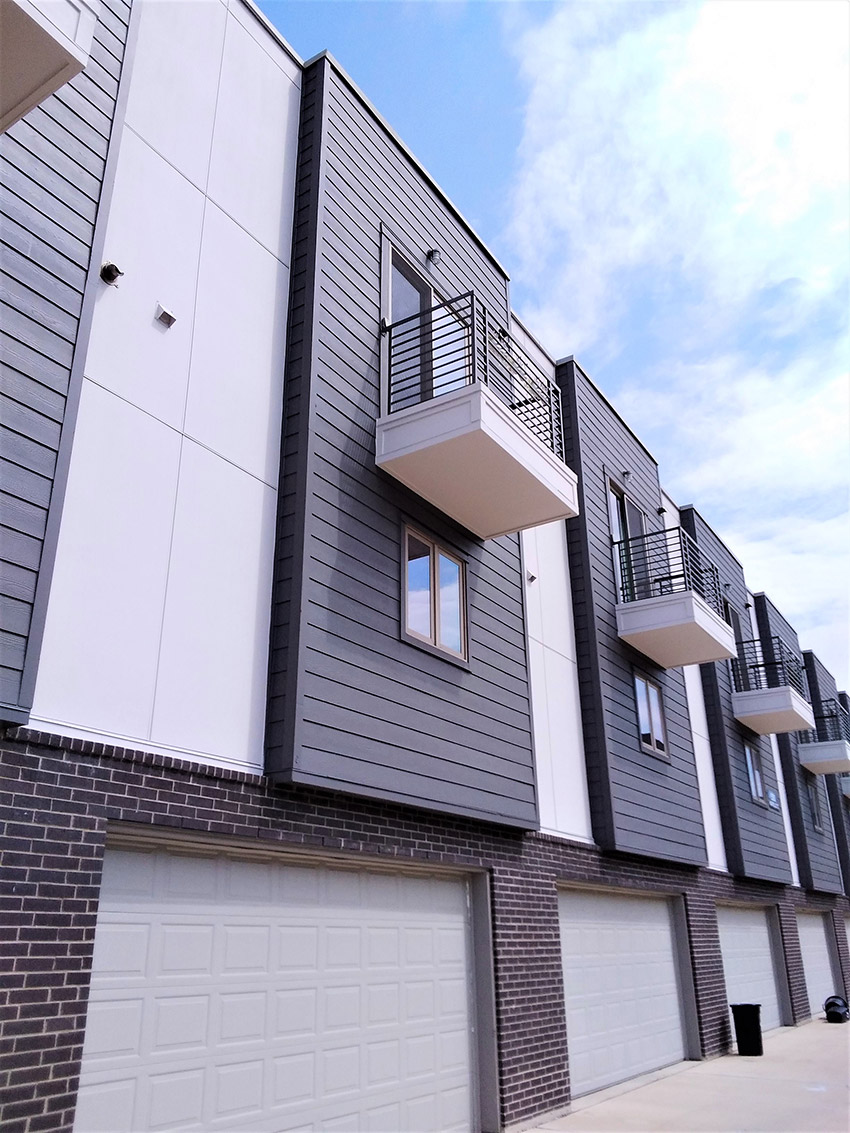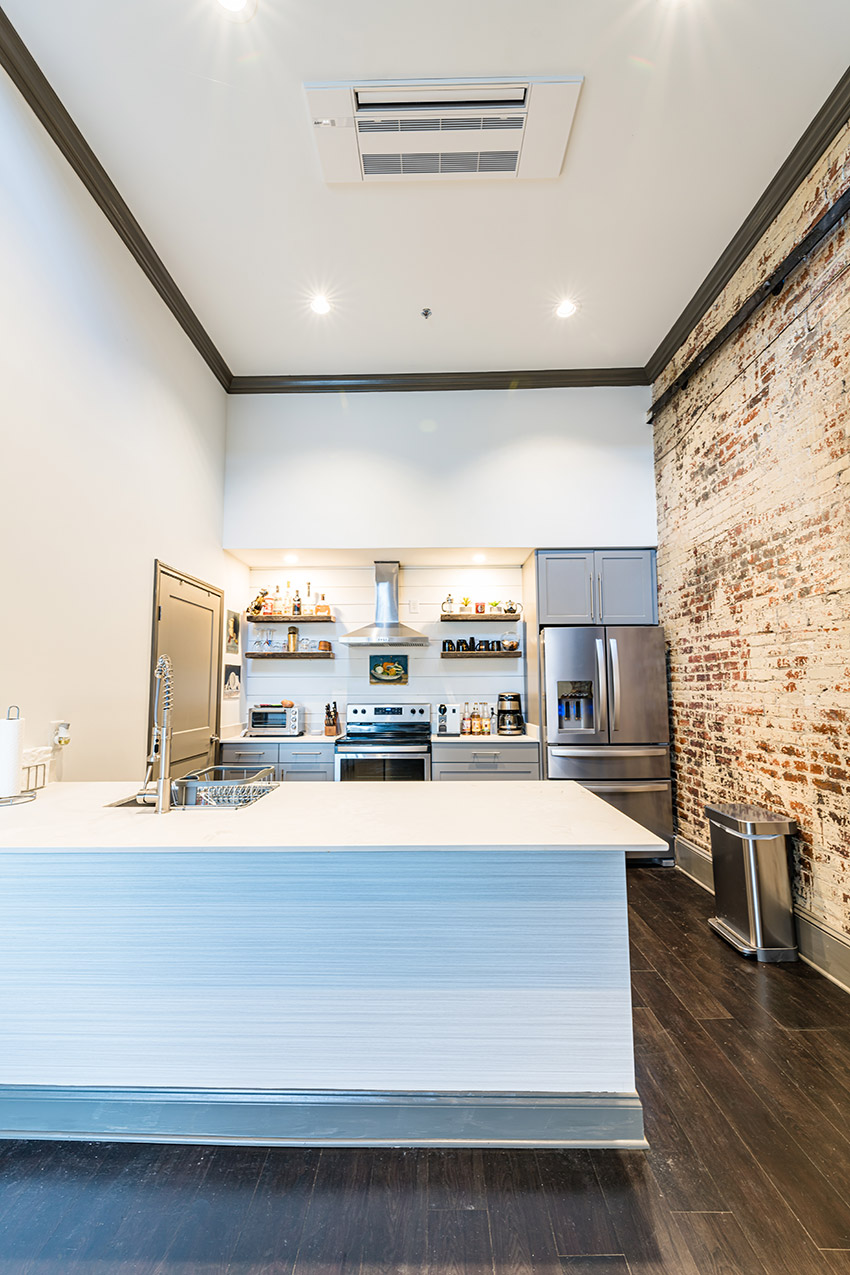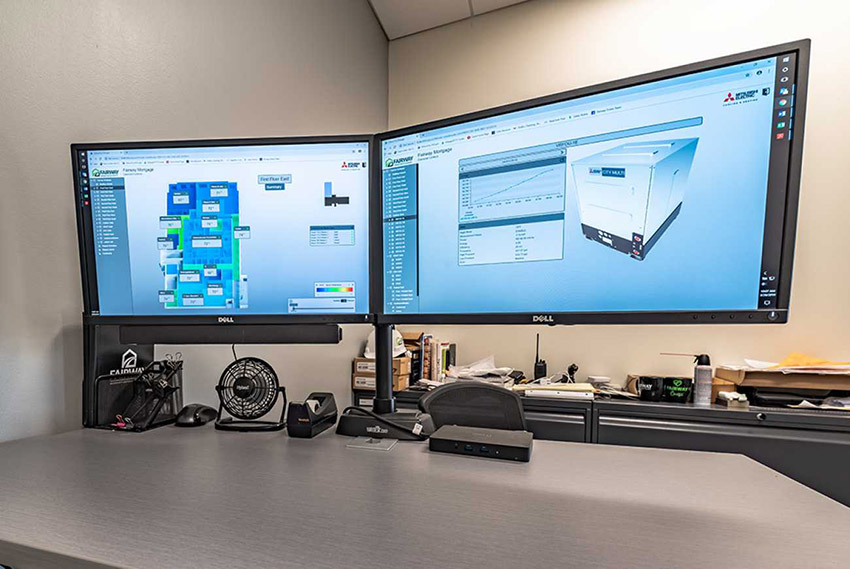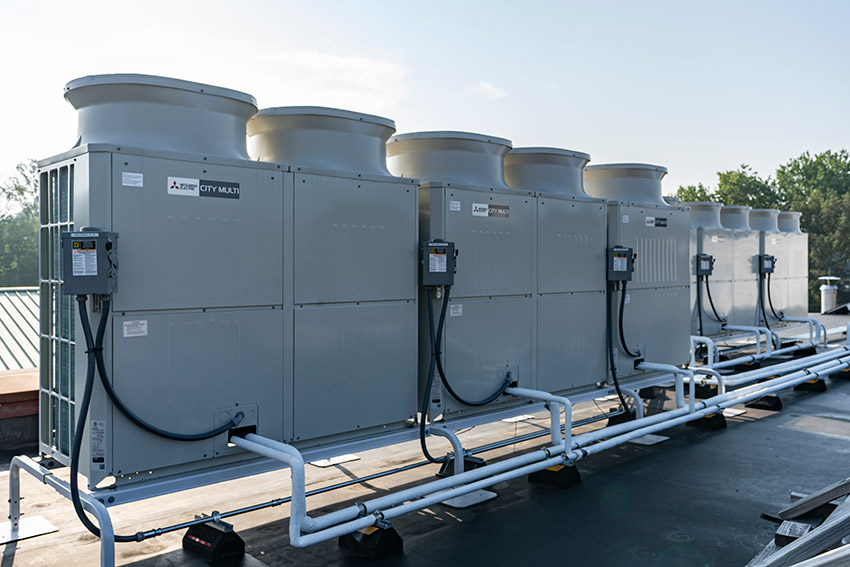Designing Efficient Multifamily Housing
Exterior Panel Trim
With the WRB and drainage addressed, holding cladding in place is another opportunity for simplification and efficiency. Typically, some sort of trim has been applied to accomplish this using wood, composite, or plastic based materials. While those are effective and can be good for some buildings, their width, bulk, and ongoing maintenance can make them less desirable for use and detract from the overall facade design. An alternative to traditional exterior trim is the use of thin, extruded aluminum trim systems. When used to hold the edges of exterior wall panels, or siding, it provides architects with a unique means to detail corners, vertical and horizontal joints, and material transitions.

Photo courtesy of Tamlyn
Extruded aluminum trim can be used to help secure and frame exterior cladding edges using either 1-piece or 2-piece product offerings.
In particular, two-piece extruded aluminum profiles are recommended for greater construction efficiency in handling tougher detailing situations. The two-piece design permits application of the base part first and then installation of the cover cap afterward. In tight fit situations this may be more efficient compared to using the standard trim pieces for inside or outside corners or for transitions. Due to the natural expansion and contraction of aluminum, all two-piece caps must be secured by adhesive or other means as approved by the manufacturer.
Aluminum trim, in both one-piece and two-piece solutions, can be specified in common thicknesses and profiles to suit any of the lightweight cladding materials commonly in use. Extruded aluminum trim can even be provided in sizes and styles that work with multiple panels enabling architects to vary the material choices within their facade designs while still keeping details that will have a similar language. The variety of available extrusion profiles can create a recessed reveal between cladding panels or can project outward to accentuate the lines of the design. Used in any of these ways, it has typically been shown to be less expensive with a more elegant look of clean lines than with other options.
Efficient Vrf Air-Source Heat Pump Systems
In multifamily buildings, energy use in each unit can vary widely based on occupant lifestyle and preferences. In order to achieve better control of energy use (and the costs associated with it) an energy-efficient, high-performance HVAC solution is needed. An increasingly popular solution is to use Variable Refrigerant Flow (VRF) systems for both cooling and heating of the dwelling units. The nature of these systems is to use an external heat pump connected to ductless or ducted indoor units that deliver heating or cooling.
System Options
As VRF zoned systems have become more popular, the range of choices for their installation has increased. By now, the “mini-split” system with a wall-mounted indoor unit has become familiar to many design professionals and consumers. However, there are many other options available including ceiling cassettes that can be surface-mounted or recessed and ducted styles such as compact air handlers. At least one manufacturer offers a cassette system that recesses between ceiling joists to provide a clean, flush-mount appearance. The slim body design fits into the shallow ceiling framing cavities, making it a desirable solution for renovation projects or new buildings that use wood framed construction. High/low ceiling airflow settings and automatic vane control features allow for personalized room comfort when using these systems.

Photo courtesy of Mitsubishi Electric Trane HVAC US
This multifamily renovation project in Macon, Georgia uses recessed ceiling cassettes, which fit between standard 16-inch joists to provide efficient, attractive, and economical heating and cooling.
The capacity range of VRF systems is also appealing, particularly for buildings that are already designed to meet high standards of energy performance. Passive House multifamily buildings, for example, are designed and constructed to dramatically reduce energy demand for heating and cooling to begin with. As such, the heating and cooling output requirements of an HVAC unit for an individual living space can be much lower. Finding and matching appropriately sized equipment to the energy needs of those dwellings is much easier with VRF zoning systems than with other types of heating and cooling equipment.
Zoning and Controls
The efficiency of VRF systems comes not only from their all-electric, high-performance technology, but also from the ability to create zoning and control solutions that suit occupants’ unique needs in each room or space. That means only the precise amount of energy needed to heat or cool a space is used, which can significantly improve a building’s overall efficiency. With zoning capabilities, occupants in multifamily buildings can enjoy individual comfort control with no impact from neighboring apartments or condos.

Photo courtesy of Mitsubishi Electric Trane HVAC US
The control of VRF systems can be centralized for large buildings and tied directly into a whole-building energy management system.
For common spaces, community areas, or amenity locations, VRF heat pumps combined with air handlers and heat recovery equipment can meet spaces’ specific needs with comparable efficiency. In these cases, comprehensive controls solutions for VRF systems allow building owners to manage energy usage and streamline maintenance needs on a large scale. Seamless interfaces are possible for whole-building controls solutions which can integrate the control of VRF technology with energy recovery ventilation equipment and other third-party systems. If certain amenities and community areas are closed overnight, for example, airflow can be turned off or the temperature set back during off hours and automatically restarted in the morning. Similarly, airflow and temperature can be adjusted to meet occupancy needs in high-trafficked public areas, such as lobbies or gyms, during peak times. On the tenant level, certain VRF system controls can be configured for accessibility via smart phone-based apps. These individual control solutions can be compatible with modern smart home technologies to ensure residents have individual comfort control right at their fingertips.
Design Coordination
Part of the design appeal of VRF systems is their design flexibility and varied styles, which can meet a range of aesthetic and spatial conditions. Outdoor units, regardless of tonnage, often boast a smaller footprint than conventional outdoor compressors, allowing for more usable rooftop or building-side space for amenities. Ultra-quiet sound levels allow tenants to enjoy nearby amenities without the distraction of sound. Inside the building, conditioned refrigerant is transferred to indoor units via small-diameter piping minimizing the space needed for piping runs. For ducted situations, only short or compact duct runs are typically needed. All of this means that usable building space is maximized by reducing the need for bulkheads or additional plenums. Perhaps most notably, the units are distributed rather than centralized, which means space requirements for mechanical rooms are also reduced. Architects can utilize all these design considerations to demonstrate how the use of VRF systems can actually lead to overall construction cost savings. For instance, buildings that no longer require plenums for ductwork can be designed to be shorter, requiring less materials and labor, but still have the same amount of livable space.

Photo courtesy of Mitsubishi Electric Trane HVAC US
The outdoor components of a VRF system are commonly much quieter and more compact than conventional heating and cooling systems.
Dennis Cobb is the senior director of business development at Mitsubishi Electric Trane HVAC US. He has seen firsthand the impact that these types of HVAC systems make on efficiency in multifamily buildings. He notes: “All-electric VRF systems are an ideal solution for multifamily projects. Tenants can enjoy custom comfort control that’s unavailable to them in apartment buildings with traditional systems, as well as cost savings thanks to system’s efficiency.
Building owners benefit from reduced costs of operation and design-friendly options that can increase their usable square footage. Quiet operation from both the indoor and outdoor units adds to the comfort of tenants and surrounding communities. They’re really great systems for everyone involved.” He also notes that when design professionals partner directly with VRF companies during design, they can provide manufacturer support to help streamline equipment design selections, system startup, maintenance, and ongoing management for optimized performance.
Notice

www.crl-arch.com

www.mitsubishicomfort.com

www.tamlyn.com









